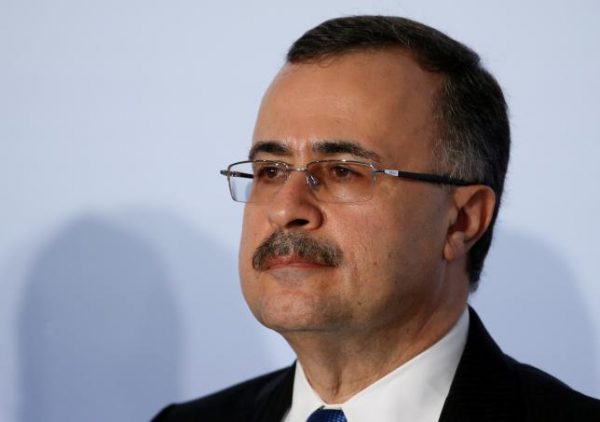
Saudi oil giant Aramco is gaining market share and pushing for greater efficiency, chief executive Amin Nasser said in an interview, as it acts as a “bridge” to a future when the nation relies less on energy exports.
Nasser also told Reuters that the state-owned group was pressing on with preparations for its partial privatization via a stock market listing, which he said lay at the heart of Riyadh’s “Vision 2030”, a long-term economic plan headed by Deputy Crown Prince Mohammed bin Salman.
Riyadh has been the driving force behind OPEC’s decision in November 2014 to refuse to cut supply to boost prices. Instead it opted to raise output and fight for market share against higher-cost rivals such as U.S. shale producers – as well as fellow OPEC member Iran which has ramped up its exports since the lifting of international sanctions.
“We are preserving our market share which continues to increase year-on-year,” he said in the interview, conducted on Wednesday. “This year, as last year, it is increasing. Our market share is picking up,” he added, without giving figures.
Aramco’s crude oil exports averaged 7.1 million bpd, up from around 6.8 million bpd in 2014, it said in its 2015 annual review released late on Thursday.
Asia accounted for 65 percent of its total oil exports; an increase from 62.3 percent a year earlier.
An OPEC meeting on June 2 will be the first for new Saudi energy minister Khalid al-Falih – Saudi Aramco’s chairman – at a time when Iranian exports have risen close to pre-sanctions level.
Riyadh’s current tactics seem to be working. Oil LCOc1 has recovered to $50 a barrel from a 12-year low of $27 in January despite the Iranian increase.
Nasser said he expects prices to “trend upward by the end of the year” as global demand picks up and production from high-cost producers, such as shale oil and deep water offshore fields, falls.
THE HEART OF VISION 2030
He saw energy continuing to play a major role while Vision 2030 aims to address falling oil revenue and sharp fiscal deficits by boosting the private sector, ending government waste and diversifying the economy. Central to this is the planned initial public offering (IPO) of Aramco shares.
“Listing Saudi Aramco is in the heart of Vision 2030. We are seriously working on the IPO,” Nasser said. “Of course, the oil and gas sector will be the bridge to the long-term and we need to maximize our revenue by introducing more efficiency in the sector.”
“Vision 2030 isn’t saying no to oil by 2020. What we need is to diversify our economy and we should have a more sustainable economy because we shouldn’t be totally dependent on one commodity,” he added.
Aramco is working on the options for floating less than 5 percent of its value, which include a single domestic stock exchange listing and a dual listing with a foreign market, Nasser said.
The company is finalizing its proposals and will present them to its Supreme Council soon, which could see part of Aramco publicly listed by 2017-18. However, Nasser said the timeframe was not set yet.
As part of Aramco’s market share push, the company plans to raise its total refining capacity – both inside the kingdom and abroad – to 8 million-10 million barrels per day from around 5.4 million bpd now.
This week it signed an agreement to supply up to 270,000 bpd of crude oil to a refinery it will jointly upgrade with Indonesia’s Pertamina.
Forecasting growing crude oil demand, Aramco has said it was seeking to invest further downstream as part of broader expansion plans in several markets such as China, India, Vietnam and the United States.
MAINTAINING OIL CAPACITY
Riyadh has traditionally kept an expensive “spare cushion” of excess production capacity, allowing it to raise or reduce levels to influence prices according to the government’s market strategy. Private oil companies, by contrast, do not hold back output for strategic gain.
Nasser said that for the time being Aramco’s maximum sustainable capacity would stay at 12 million bpd despite its plans to build new refineries and expand its petrochemicals business.
“If you use oil in refining, in chemicals or to produce chemicals or products, it will be part of the maximum sustainable capacity of Saudi Aramco, so 12 million bpd for the time being is the capacity,” he said.
The company pumped on average about 10.2 mln bpd in 2015 “which means we still have ample spare capacity”, he said.
That was an all-time record, Aramco said in its 2015 annual review.
While the global rig count has dropped substantially, the number of Aramco’s rigs is increasing slightly due to significant growth especially in the downstream and petrochemicals sector and in gas for domestic consumption.
Under the government’s diversification plans, the kingdom plans to generate 9.5 gigawatts of electricity from renewable energy.
Nasser said Aramco is looking to play a major role in achieving that target. “Renewables is in our radar…and we are looking forward to play a major role in renewable in the near future,” he said.
The company had set up a renewable energy department and is studying plans to invest in wind and solar power.
REUTERS
Leave a Reply
You must be logged in to post a comment.